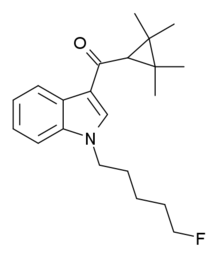XLR-11
XLR-11 (5"-fluoro-UR-144 or 5F-UR-144) is a drug that acts as a potent agonist for the cannabinoid receptors CB1 and CB2 with EC50 values of 98 nM and 83 nM, respectively.[1] It is a 3-(tetramethylcyclopropylmethanoyl)indole derivative related to compounds such as UR-144, A-796,260 and A-834,735, but it is not specifically listed in the patent or scientific literature alongside these other similar compounds,[2][3] and appears to have not previously been made by Abbott Laboratories, despite falling within the claims of patent WO 2006/069196. XLR-11 was found to produce rapid, short-lived hypothermic effects in rats at doses of 3 mg/kg and 10 mg/kg, suggesting that it is of comparable potency to APICA and STS-135.[1]
 | |
| Legal status | |
|---|---|
| Legal status |
|
| Identifiers | |
| |
| CAS Number | |
| PubChem CID | |
| ChemSpider | |
| UNII | |
| CompTox Dashboard (EPA) | |
| Chemical and physical data | |
| Formula | C21H28FNO |
| Molar mass | 329.459 g·mol−1 |
| 3D model (JSmol) | |
| |
| |
Detection
A forensic standard for this compound is available, and a representative mass spectrum has been posted on Forendex.[4]
Recreational use
XLR-11 was instead first identified by laboratories in 2012 as an ingredient in synthetic cannabis smoking blends, and appears to be a novel compound invented specifically for grey-market recreational use.[5]
Legal Status
XLR-11 was banned in New Zealand by being added to the temporary class drug schedule, effective from 13 July 2012.[6]
The U.S. Drug Enforcement Administration (DEA) made the synthetic cannabinoids UR-144, XLR11, and AKB48 Schedule I, illegal drugs under the Controlled Substances Act (CSA) for the next two years as of 16 May 2013.[7]
It has also been banned in Florida as of December 11, 2012.[8]
Arizona banned XLR-11 on 3 April 2013.[9]
As of October 2015 XLR-11 is a controlled substance in China.[10]
XLR-11 is banned in the Czech Republic.[11]
Side effects
XLR-11 has been linked to hospitalizations due to its use.[12]
Toxicity
XLR-11 has been linked to acute kidney injury in some users,[13] along with AM-2201.[14][15]
References
- Banister, S. D.; Stuart, J.; Kevin, R. C.; Edington, A.; Longworth, M.; Wilkinson, S. M.; Beinat, C.; Buchanan, A. S.; Hibbs, D. E.; Glass, M.; Connor, M.; McGregor, I. S.; Kassiou, M. (2015). "Effects of Bioisosteric Fluorine in Synthetic Cannabinoid Designer Drugs JWH-018, AM-2201, UR-144, XLR-11, PB-22, 5F-PB-22, APICA, and STS-135". ACS Chemical Neuroscience. 6 (8): 1445–1458. doi:10.1021/acschemneuro.5b00107. PMID 25921407.
- WO application 2006069196, Pace JM, Tietje K, Dart MJ, Meyer MD, "3-Cycloalkylcarbonyl indoles as cannabinoid receptor ligands", published 2006-06-29, assigned to Abbott Laboratories
- Frost JM, Dart MJ, Tietje KR, Garrison TR, Grayson GK, Daza AV, El-Kouhen OF, Yao BB, Hsieh GC, Pai M, Zhu CZ, Chandran P, Meyer MD (January 2010). "Indol-3-ylcycloalkyl ketones: effects of N1 substituted indole side chain variations on CB(2) cannabinoid receptor activity". J. Med. Chem. 53 (1): 295–315. doi:10.1021/jm901214q. PMID 19921781.
- "XLR-11". Structural, chemical, and analytical data on controlled substances. Southern Association of Forensic Scientists (SAFS).
- Wilkinson, S. M.; Banister, S. D.; Kassiou, M. (2015). "Bioisosteric Fluorine in the Clandestine Design of Synthetic Cannabinoids". Australian Journal of Chemistry. 68: 4. doi:10.1071/CH14198.
- "CB-13, MAM-2201, AKB48, and XLR11 are classified as temporary class drugs". Temporary Class Drug Notice. The Department of Internal Affairs: New Zealand Gazette. 5 July 2012.
- "DEA Makes Three More "Fake Pot" Drugs Temporarily Illegal Today" (Press release). 16 June 2013.
- "Attorney General Pam Bondi Outlaws Additional Synthetic Drugs" (Press release). State of Florida. 11 December 2012.
- "Governor Jan Brewer Signs Legislation to Combat Production, Use of Dangerous Drugs" (PDF) (Press release). Office of the Governor, State of Arizona. Archived from the original (PDF) on 7 June 2013. Retrieved 27 August 2014.
- "关于印发《非药用类麻醉药品和精神药品列管办法》的通知" (in Chinese). China Food and Drug Administration. 27 September 2015. Retrieved 1 October 2015.
- "Látky, o které byl doplněn seznam č. 4 psychotropních látek (příloha č. 4 k nařízení vlády č. 463/2013 Sb.)" (PDF) (in Czech). Ministerstvo zdravotnictví.
- Jordan Trecki; Roy R. Gerona; Michael D. Schwartz (July 2015). "Synthetic Cannabinoid–Related Illnesses and Deaths". New England Journal of Medicine. 373 (2): 103–107. doi:10.1056/NEJMp1505328. PMID 26154784.
- "Alphabet Soup, or the newer synthetic cannabinoids..." The Dose Makes The Poison Blog. 11 December 2013. Retrieved 18 September 2014.
- Bhanushali GK, Jain G, Fatima H, Leisch LJ, Thornley-Brown D (April 2013). "AKI associated with synthetic cannabinoids: a case series". Clin J Am Soc Nephrol. 8 (4): 523–6. doi:10.2215/CJN.05690612. PMC 3613952. PMID 23243266.
- "Acute Kidney Injury Associated with Synthetic Cannabinoid Use — Multiple States, 2012". Morbidity and Mortality Weekly Report. U.S. Centers for Disease Control and Prevention (CDC). 15 February 2013. Retrieved 15 February 2013.